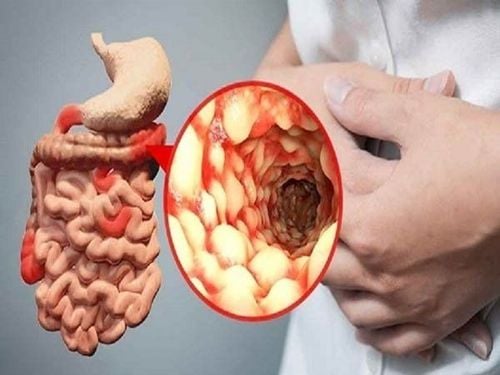This is an automatically translated article.
This article is professionally consulted by Master, Resident Doctor Dang Thi Ngoan - Pediatrician - Neonatologist - Department of Pediatrics - Neonatology - Vinmec Ha Long International Hospital.Children vomiting after feeding is a manifestation of food in the stomach being pushed up the esophagus and then out into the mouth, causing the child to anorexia and affecting the child's development.
1. The phenomenon of vomiting in infants
Vomiting is a manifestation of food in the stomach being pushed back up the esophagus and then out into the mouth. The phenomenon of regurgitation is most common in infants, especially when the child is full, twists and turns. Physiological regurgitation in infants usually does not affect the health of the child. However, vomiting is also a manifestation of a medical condition, and is often accompanied by other signs such as:Crying while feeding Stomach distended stomach Cramping pain, abdominal swelling Falling into a state of lethargy There is a phenomenon of convulsions Dehydration, dry mouth Vomiting with blood or yellow, blue color Vomiting while feeding can be a manifestation of some diseases such as intestinal obstruction, intussusception, calcium deficiency,... Therefore, it should not be Subjective, it is necessary to monitor the child's expression and weight. In addition, it is necessary to pay attention to the child's menu to see if there is a lack of some substances so that it can be supplemented in time.
Trắc nghiệm: các chỉ số cần chú ý về sự phát triển thể chất của trẻ
Chiều cao, cân nặng của bé ở từng giai đoạn nên là bao nhiêu là bình thường, bao nhiêu là bất thường? Cùng ThS.BS Ma Văn Thấm điểm lại xem bạn đã nắm được các chỉ số phát triển thể chất của bé chưa nhé!The following content is prepared under supervision of Thạc sĩ, Bác sĩ y khoa, Ma Văn Thấm , Nhi , Phòng khám Đa khoa Quốc tế Vinmec Dương Đông(Phú Quốc)
2. Causes of vomiting after feeding
2.1 Physiological vomiting The cause of regurgitation in infants is due to the immature digestive system, horizontal stomach and weak cardiac sphincter. Therefore, when children eat full, often lead to vomiting. In addition, it may be because the mother's care is not correct such as:Feeding the baby too much, forcing the baby to suckle too much The child sucking in the wrong position, improperly sucking the bottle, causing the child to swallow a lot of gas in the stomach. The baby has just finished eating and put the baby to bed. Diapers or umbilical cords are too blocking The taste of food is not suitable

2.2.1 Vomiting in medical conditions
Some Medical diseases causing vomiting symptoms in infants such as:
Gastrointestinal diseases: Slow intestinal motility, diarrhea Upper respiratory tract inflammation Increased intracranial pressure: Brain hemorrhage due to decreased prothrongbil ratio Nervous infections such as meningitis, adrenal gland syndromes Autonomic nervous system disorders: pyloric spasm 2.2.2 Vomiting in surgical pathology
Vomiting due to gastrointestinal foreign body: Congenital duodenal stricture , pyloric stenosis, esophageal atrophy, diaphragmatic hernia. Babies often show vomiting in the first few days after birth. Vomiting due to intestinal volvulus, intestinal obstruction: Often accompanied by systemic infection, bowel obstruction, abdominal distension and bloody stools, black gastric juice.
3. How to overcome children vomiting after feeding

3.1 Feeding the baby correctly Based on the structure and anatomical position of the stomach, it is advisable to feed the baby on the left side first because at this time the amount of gastric juice is still small. Then, when the stomach contains a lot of milk, it is necessary to switch to the right feeding because the baby needs to lie on the left side. This way the milk will easily come down and stay in the stomach without refluxing.
In addition, while nursing, if the baby is fussy, stop sucking immediately to avoid choking. Children should not be breastfed too much, need to divide them into many meals, each 2-4 hours apart.
3.2 Maintain the correct posture after feeding After feeding, the mother needs to hold the baby with her head high for about 15-20 minutes, do not let the baby lie down. Gently pat the back to push air out of the stomach, helping the baby burp well.
3.3 Loosening clothes Clothes, diapers are too tight, causing the abdominal wall and stomach to be compressed, so the baby is easy to vomit. Therefore, mothers should loosen children's clothes, wear loose-fitting clothes as much as possible, especially around the abdomen.
In addition, if the baby spits up after feeding, the mother needs to tilt the baby's head to the side to avoid choking on the vomit. Clean up vomit from your child's nose, mouth, and throat by sucking or blotting with gauze. When vomiting stops, give the child warm water, oresol slowly. Finally evaluate the vomit, and continue to monitor the child.
Vomiting after feeding in infants is a common phenomenon in infants. If the baby just spits up normally, the mother should not be too worried but calm down and handle it according to the above advice of Vinmec. But if the baby vomits with unusual symptoms such as abdominal pain, convulsions, blood, the mother needs to take the baby to a medical facility immediately because it is likely that the baby is suffering from a dangerous disease.
In Vietnam today, 7 out of 10 children under 5 years old have zinc deficiency and 8 pregnant women have zinc deficiency. The prevalence of zinc deficiency in pregnant women is 80.3%, women of childbearing age 63.6% and children under 5 years old is 69.4%. The most common manifestations of zinc deficiency in children are growth retardation, mild and moderate malnutrition, delayed growth in height, and some observable symptoms such as anorexia or decreased appetite, decreased suckling, and no meat. fish, slow digestion, mild constipation, persistent nausea and vomiting in children. In addition to reasonable zinc supplementation, parents also need to provide their children with other important vitamins and minerals such as lysine, chromium, B vitamins,... resistance to minor illnesses and less digestive problems.
Please visit the website vimec.com regularly and update useful information to take care of your baby and family.















